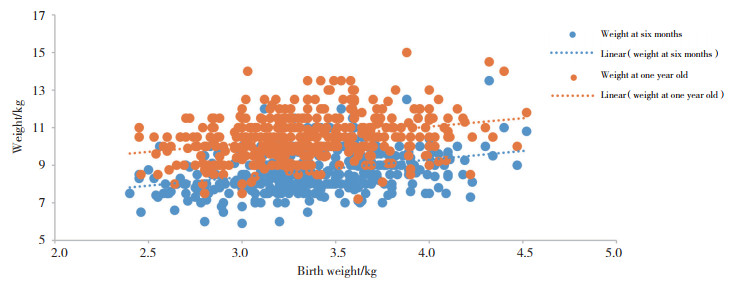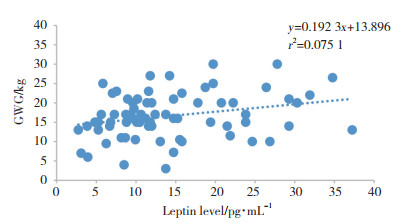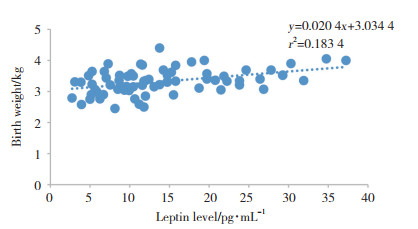文章信息
- 路柯, 丁雅洁, 张宁馨, 王雪松, 胡嘉晋, 刘洋, 贾丽红
- LU Ke, DING Yajie, ZHANG Ningxin, WANG Xuesong, HU Jiajin, LIU Yang, JIA Lihong
- 孕妇孕期增重对婴儿体格发育影响的队列研究
- Effects of gestational weight gain on infant physical development: a cohort study
- 中国医科大学学报, 2023, 52(3): 206-211
- Journal of China Medical University, 2023, 52(3): 206-211
-
文章历史
- 收稿日期:2022-10-13
- 网络出版时间:2023-03-16 09:48:46
2. 辽宁省肥胖与糖脂代谢性疾病重点实验室,沈阳 110122;
3. 中国医科大学健康科学研究院,沈阳 110122
2. Key Laboratory of Obesity and Glycolipid Metabolism Diseases of Liaoning Province, Shenyang 110122, China;
3. Institute of Health Sciences, China Medical University, Shenyang 110122, China
儿童肥胖症是全球最严重的公共卫生问题之一。1975年至2016年,全球5~19岁女童的年龄标准化肥胖患病率从0.7%增加到5.6%,男童从0.9%增加到7.8%[1]。《中国居民营养与慢性病状况报告(2020年)》显示,我国6~17岁及6岁以下的儿童青少年超重肥胖率分别达到19%和10.4%[2]。肥胖危害儿童身心健康,且肥胖儿童成年后的肥胖风险增加,并伴有2型糖尿病、心血管疾病和代谢综合征的高易感性[3]。研究[4]发现,婴儿期是儿童体格发育的关键时期,婴儿出生后第1年生长加速与4~6岁儿童超重风险增加有关。婴儿出生到5个月体质量快速增加与9~14岁青少年超重风险增加有关[5]。而婴儿体格发育可能与孕妇孕期增重(gestational weight gain,GWG)有关,DIESEL等[6]认为孕妇GWG过多可能使婴儿倾向于肥胖性生长模式;ZHANG等[7]研究显示孕妇GWG过多会增加婴儿12个月时超重或肥胖的风险。然而,国内外也有研究[8-9]显示孕妇GWG与婴儿出生后第1年的生长轨迹无关。关于孕妇GWG对婴儿体格发育影响的研究结论尚不一致。此外,有研究发现孕妇GWG过多与脐带高瘦素血症风险增加3倍相关[10],而脐带血瘦素也与婴儿体格发育密切相关[11]。但有关脐带血瘦素水平与0~1岁婴儿体格发育的研究报道较少。因此,本文对沈阳市孕妇GWG对0~1岁婴儿体格发育的影响进行队列研究,并探讨瘦素在其中的作用,为今后制定有效的干预措施,从生命早期开始预防今后儿童青少年超重肥胖的发生发展提供参考依据。
1 材料与方法 1.1 研究对象采用方便抽样法,抽取2019年9月至2020年9月于中国医科大学附属第四医院住院分娩的464对母子对。并在婴儿6月龄及1岁时进行随访,共随访到414名6月龄婴儿和408名1岁婴儿。排除标准:(1)孕妇年龄 < 18岁;(2)孕妇孕前存在心血管、内分泌、泌尿系统、代谢性疾病、自身免疫性疾病及神经肌肉病;(3)孕妇入院时存在感染(如发热、绒毛膜羊膜炎等);(4)人工授精;(5)多胎妊娠;(6)孕妇身高、孕前或孕后期体质量值缺失;(7)新生儿存在窒息史或有出生缺陷。本研究获得医学伦理委员会批准(EC-2019-KS-027)。
1.2 方法 1.2.1 信息收集在孕妇知情同意后,由经过统一培训的儿科医生对孕妇进行问卷调查,收集孕妇孕前体质量、文化程度、自觉家庭经济状况、孕次等信息,采用标准身高体质量测量仪,测量孕妇的身高和分娩前3 d内的体质量。通过分娩记录,收集新生儿性别、孕周、出生身长、出生体质量等信息。由经过统一培训的儿科医生对6月龄及1岁婴儿进行随访,收集婴儿喂养方式、辅食添加情况等信息,并采用标准身高体质量测量仪测量婴儿体质量和身长。
1.2.2 GWG的分类GWG指孕妇分娩体质量与孕前体质量之差。根据2021年中国营养学会发布的《中国妇女妊娠期体重监测与评价》指南对孕妇GWG进行分类。该指南根据我国成年人身体质量指数(body mass index,BMI)分类标准对孕妇孕前BMI进行分类,并分别为孕前体质量过轻(BMI < 18.5 kg/m2)、正常(BMI 18.5~23.9 kg/m2)、超重(BMI 24.0~27.9 kg/m2)和肥胖(BMI≥28.0 kg/m2)的孕妇推荐了适宜的总GWG范围:11.5~16.0 kg、8.0~14 kg、7.0~11.0 kg和5.0~9.0 kg。孕妇GWG低于此标准为GWG不足,符合此标准为GWG适宜,超过此标准为GWG过多[12]。
1.2.3 脐带血瘦素的检测由产科医护人员采集新生儿脐静脉血样本8~10 mL,通过离心分离血清,将血清储存于-80 ℃冰箱中。随机抽取74例血清样本,使用ELISA试剂盒(上海R & D Systems公司)检测脐带血瘦素水平。
1.3 统计学分析采用SPSS 22.0软件进行统计分析。计量资料以x±s来表示,计数资料以率(%)来表示。采用F检验进行多组间均数的比较。采用多重线性回归分析孕妇GWG对0~1岁婴儿体格发育的影响。釆用Pearson相关对满足正态分布的连续变量进行相关性分析;釆用Spearman相关对不满足正态分布的连续变量进行相关性分析。P < 0.05为差异有统计学意义。
2 结果 2.1 一般情况本研究共纳入464对母子对,共随访到414名6月龄婴儿和408名1岁婴儿。孕妇GWG不足的检出率为6.3%,过多的检出率为70.9%。见表 1。
| Characteristics | Inadequate GWG(n = 29) | Adequate GWG(n = 106) | Excessive GWG(n = 329) | P |
| Age [n(%)] | 0.245 | |||
| < 25 years | 3(10.3) | 5(4.7) | 28(8.5) | |
| 25-29 years | 14(48.3) | 48(45.3) | 174(52.9) | |
| > 29 years | 12(41.4) | 53(50.0) | 127(38.6) | |
| Pre-pregnancy BMI [n(%)] | 0.001 | |||
| Underweight | 5(17.2) | 23(21.7) | 34(10.3) | |
| Normal | 13(44.8) | 63(59.4) | 207(62.9) | |
| Overweight | 4(13.8) | 17(16.0) | 65(19.8) | |
| Obese | 7(24.1) | 3(2.8) | 23(7.0) | |
| Education [n(%)] | 0.003 | |||
| ≤Junior school | 8(27.6) | 10(9.4) | 36(11.0) | |
| High school | 1(3.4) | 10(9.4) | 42(12.9) | |
| College or university | 18(62.1) | 72(67.9) | 236(72.4) | |
| ≥Graduate school | 2(6.9) | 14(13.2) | 12(3.7) | |
| Passive smoking during pregnancy [n(%)] | 0.628 | |||
| Yes | 9(31.0) | 29(28.2) | 105(33.2) | |
| No | 20(69.0) | 74(71.8) | 211(66.8) | |
| Gravidity [n(%)] | 0.649 | |||
| 1 | 14(48.3) | 66(62.3) | 196(59.6) | |
| 2 | 9(31.0) | 25(23.6) | 88(26.7) | |
| ≥3 | 6(20.7) | 15(14.2) | 45(13.7) | |
| Parity [n(%)] | 0.132 | |||
| 1 | 18(62.1) | 76(71.7) | 254(77.2) | |
| ≥2 | 11(37.9) | 30(28.3) | 75(22.8) | |
| Household financial status [n(%)] | 0.417 | |||
| Well | 3(10.3) | 4(3.8) | 22(6.7) | |
| Normal | 23(79.3) | 87(82.9) | 247(75.8) | |
| Bad | 3(10.3) | 14(13.3) | 57(17.5) | |
| Child sex [n(%)] | 0.438 | |||
| Male | 12(41.4) | 53(50.0) | 175(53.2) | |
| Female | 17(58.6) | 53(50.0) | 154(46.8) | |
| Gestational age(x±s,week) | 38.21±0.98 | 38.77±0.91 | 38.76±1.00 | 0.013 |
| Mode of infant feeding(0-6 months)[n(%)] | 0.088 | |||
| Exclusive breastfeeding | 12(41.4) | 59(55.7) | 168(51.1) | |
| Exclusive formula feeding | 2(6.9) | 17(16.0) | 64(19.5) | |
| Mixed breast and formula | 15(51.7) | 30(28.3) | 97(29.5) | |
| Mode of infant feeding(6-12 months)[n(%)] | 0.470 | |||
| Exclusive breast feeding | 11(39.3) | 36(34.6) | 119(38.0) | |
| Exclusive formula feeding | 7(25.0) | 40(38.5) | 122(39.0) | |
| Mixed breast and formula | 10(35.7) | 28(26.9) | 72(23.0) | |
| Types of complementary foods(6-12 months)[n(%)] | 0.593 | |||
| Variety(> 10 kinds) | 21(75.0) | 81(80.2) | 228(75.0) | |
| General(3-10 kinds) | 6(21.4) | 16(15.8) | 69(22.7) | |
| Few(< 3 kinds) | 1(3.6) | 4(4.0) | 7(2.3) |
2.2 不同GWG组0~1岁婴儿的体质量及身长情况
不同GWG组新生儿的出生体质量和出生身长差异均有统计学意义(P < 0.05)。不同GWG组6月龄及1岁婴儿的体质量差异均有统计学意义(P < 0.05),但身长均无统计学差异(P > 0.05),见表 2。
| Items | Inadequate GWG | Adequate GWG | Excessive GWG | F | P | |||||
| n | x±s | n | x±s | n | x±s | |||||
| Birth weight(kg) | 29 | 3.16±0.38 | 106 | 3.21±0.33 | 329 | 3.42±0.41 | 15.558 | < 0.001 | ||
| Birth length(cm) | 29 | 49.52±1.33 | 106 | 50.19±1.44 | 329 | 50.58±1.59 | 7.838 | < 0.001 | ||
| Weight at six months(kg) | 27 | 8.72±1.01 | 93 | 8.43±0.94 | 294 | 8.80±1.14 | 4.105 | 0.017 | ||
| Length at six months(cm) | 27 | 69.15±2.87 | 93 | 69.13±2.32 | 294 | 69.28±2.67 | 0.144 | 0.866 | ||
| Weigh at one year old(kg) | 26 | 10.29±1.14 | 89 | 10.19±1.02 | 293 | 10.59±1.23 | 4.357 | 0.013 | ||
| Length at one year old(cm) | 26 | 76.57±2.53 | 89 | 77.00±2.59 | 293 | 77.32±2.78 | 1.204 | 0.301 | ||
2.3 孕妇GWG与0~1岁婴儿体质量及身长的回归分析
线性回归分析结果显示,调整各混杂因素(母亲孕前BMI、文化程度、自觉家庭经济状况、孕次、孕周和新生儿性别)后,与孕妇GWG适宜组相比,孕妇GWG过多会导致新生儿出生体质量(β = 0.20,95%CI:0.12~0.28,P < 0.001)和出生身长(β = 0.44,95%CI:0.11~0.77,P < 0.05)显著增高,但孕妇GWG不足对新生儿出生体质量和出生身长均无显著影响(P > 0.05)。孕妇GWG对6月龄及1岁婴儿体质量均无显著影响(P > 0.05),见表 3。
| Weight/length | GWG | β | 95%CI | t | P |
| Birth weight | Adequate | 0 | - | - | - |
| Inadequate | -0.02 | -0.18-0.13 | -0.312 | 0.756 | |
| Excessive | 0.20 | 0.12-0.28 | 4.826 | < 0.001 | |
| Birth length | Adequate | 0 | - | - | - |
| Inadequate | -0.47 | -1.09-0.15 | -1.496 | 0.135 | |
| Excessive | 0.44 | 0.11-0.77 | 2.627 | 0.009 | |
| Weight at six months | Adequate | 0 | - | - | - |
| Inadequate | 0.31 | -0.13-0.75 | 1.373 | 0.170 | |
| Excessive | 0.20 | -0.05-0.44 | 1.570 | 0.117 | |
| Weigh at one year old | Adequate | 0 | - | - | - |
| Inadequate | 0.29 | -0.21-0.79 | 1.149 | 0.251 | |
| Excessive | 0.28 | 0.00-0.56 | 1.957 | 0.051 |
2.4 新生儿出生体质量与6月龄及1岁婴儿体质量的关系
Pearson相关分析结果显示,新生儿出生体质量与6月龄及1岁婴儿体质量均呈正相关(r = 0.341,P < 0.001;r = 0.297,P < 0.001),见图 1。

|
| 图 1 新生儿出生体质量和6月龄及1岁婴儿体质量的相关性分析 Fig.1 Correlation between birth weight and the weight of 6-month- and 1-year-old infants |
2.5 脐带血瘦素水平与孕妇GWG及0~1岁婴儿体质量的关系
Spearman相关分析结果显示,脐带血瘦素水平与孕妇GWG及新生儿出生体质量均呈正相关(r = 0.255,P = 0.028;r = 0.434,P < 0.001),但与6月龄和1岁婴儿的体质量无相关性(P > 0.05),见图 2、3。

|
| 图 2 脐带血瘦素水平与孕妇GWG之间的相关性分析 Fig.2 Correlation between leptin in cord blood and gestational weight gain of pregnant women |

|
| 图 3 脐带血瘦素水平与新生儿出生体质量之间的相关性分析 Fig.3 Correlation between leptin in cord blood and birth weight |
3 讨论
研究[13]显示,美国、欧洲和亚洲GWG不足的孕妇分别占21%、18%和31%,GWG过多的孕妇分别占51%、51%和37%。2017年至2018年,我国孕妇GWG不足和过多的检出率分别为24.8%和33.9%[14]。与上述研究结果相比,本研究中孕妇GWG过多的检出率(70.9%)过高,而GWG不足的检出率(6.3%)较低。
孕妇GWG过多是胎儿生长加速的已知危险因素[14]。此外,研究[6-7]发现孕妇GWG过多可能与婴儿超重或肥胖有关。然而,也有研究[8-9]显示孕妇GWG与婴儿生长轨迹无关。还有学者[15-16]认为,一些未测量或难以测量的母子共同家族特征(如母子共同的生活方式、家庭环境以及遗传因素)也会影响婴儿体质量,研究孕妇GWG与婴儿体质量的因果关系时,采用同胞对照分析能够控制这些因素所带来的混淆。1项同时采用了传统和同胞对照分析方法的研究[17]显示,无论采用哪种分析方法,孕妇GWG过多都与子代出生体质量较高相关,但仅在传统分析方法中,GWG过多与子代3岁时更高的BMI和肥胖风险相关。本研究结果显示,孕妇GWG过多会增加新生儿出生体质量和出生身长,但对6月龄及1岁婴儿体格发育无显著影响。此外,新生儿出生体质量与6月龄及1岁体婴儿质量均呈正相关。提示孕妇GWG会影响子代出生体质量,而新生儿出生体质量及母子共同家族特征等因素可能比孕妇GWG对婴幼儿体质量的影响作用更大。孕妇GWG可能通过影响新生儿出生体质量间接影响6月龄及1岁婴儿体质量,但也可能是母子共同的家族特征造成了新生儿出生体质量与6月龄及1岁婴儿体质量之间的相关性,其具体机制有待进一步研究。
目前,关于孕妇GWG与脐带血瘦素关系的研究较少。有研究[10]发现,孕妇GWG过多与脐带血瘦素浓度较高有关。许多研究[10-11]已证实脐带血瘦素与新生儿出生体质量呈正相关。本研究结果显示,脐带血瘦素水平与孕妇GWG和新生儿出生体质量均呈正相关,提示脐带血瘦素水平可能在孕妇GWG影响新生儿出生体质量的过程中发挥调控作用。当孕妇营养过剩或BMI较高时,子宫内营养物质过剩,导致胎儿脂肪组织中瘦素合成和分泌增加,并影响新生儿出生体质量[18]。此外,有研究[11]发现,脐带血瘦素浓度与婴儿早期体质量增加呈负相关。但本研究中脐带血瘦素水平与6月龄和1岁婴儿体质量无相关性。
综上所述,沈阳市孕妇GWG过多的情况严重,孕妇GWG过多与婴儿体格发育密切相关,瘦素可能在其中发挥重要作用。应指导孕妇保持健康的生活方式,将GWG控制在合理范围内,以促进婴儿健康生长发育。本研究存在一些不足之处。首先孕妇孕前体质量由孕妇自我报告,可能与实际情况存在偏倚。其次,本研究属于方便抽样,样本数不大,因此,样本代表性有限。
| [1] |
RISK FACTOR COLLABORATION (NCD-RISC) NCD. Worldwide trends in body-mass index, underweight, overweight, and obesity from 1975 to 2016:a pooled analysis of 2416 population-based measurement studies in 128·9 million children, adolescents, and adults[J]. Lancet, 2017, 390(10113): 2627-2642. DOI:10.1016/S0140-6736(17)32129-3 |
| [2] |
国家卫生健康委员会. 中国居民营养与慢性病状况报告(2020年)[M]. 北京: 人民卫生出版社, 2020.
|
| [3] |
刘明法, 柳红梅. 儿童肥胖对健康的影响[J]. 中国校医, 2022, 36(3): 184-188. DOI:10.3969/j.issn.1001-7062.2022.3.zgxy202203009 |
| [4] |
JONES-SMITH JC, FERNALD LCH, NEUFELD LM. Birth size and accelerated growth during infancy are associated with increased odds of childhood overweight in Mexican children[J]. J Am Diet Assoc, 2007, 107(12): 2061-2069. DOI:10.1016/j.jada.2007.09.011 |
| [5] |
ROONEY BL, MATHIASON MA, SCHAUBERGER CW. Predictors of obesity in childhood, adolescence, and adulthood in a birth cohort[J]. Matern Child Health J, 2011, 15(8): 1166-1175. DOI:10.1007/s10995-010-0689-1 |
| [6] |
DIESEL JC, ECKHARDT CL, DAY NL, et al. Gestational weight gain and offspring longitudinal growth in early life[J]. Ann Nutr Metab, 2015, 67(1): 49-57. DOI:10.1159/000437149 |
| [7] |
ZHANG WW, NIU FH, REN XY. Association of maternal pre-pregnancy body mass index and gestational weight gain with Chinese infant growth[J]. J Paediatr Child Health, 2019, 55(6): 673-679. DOI:10.1111/jpc.14274 |
| [8] |
HEERMAN WJ, BIAN AH, SHINTANI A, et al. Interaction between maternal prepregnancy body mass index and gestational weight gain shapes infant growth[J]. Acad Pediatr, 2014, 14(5): 463-470. DOI:10.1016/j.acap.2014.05.005 |
| [9] |
刘宇辞, 陶兴永, 黄锟, 等. 母亲孕前BMI和孕期增重对0~1岁儿童BMI生长轨迹影响作用的研究[J]. 现代预防医学, 2022, 49(2): 246-249, 262. DOI:10.3969/j.issn.1003-8507.2022.2.xdyfyx202202012 |
| [10] |
KARAKOSTA P, GEORGIOU V, FTHENOU E, et al. Maternal weight status, cord blood leptin and fetal growth: a prospective mother-child cohort study (Rhea study)[J]. Paediatr Perinat Epidemiol, 2013, 27(5): 461-471. DOI:10.1111/ppe.12074 |
| [11] |
CHAOIMH CN, MURRAY DM, KENNY LC, et al. Cord blood leptin and gains in body weight and fat mass during infancy[J]. Eur J Endocrinol, 2016, 175(5): 403-410. DOI:10.1530/EJE-16-0431 |
| [12] |
中国营养学会. 中国妇女妊娠期体重监测与评价[EB/OL]. (2021-09-01)[2022-10-5]. https://www.cnsoc.org/otherNotice/392100200.html.
|
| [13] |
GOLDSTEIN RF, ABELL SK, RANASINHA S, et al. Gestational weight gain across continents and ethnicity: systematic review and meta-analysis of maternal and infant outcomes in more than one million women[J]. BMC Med, 2018, 16(1): 153. DOI:10.1186/s12916-018-1128-1 |
| [14] |
SUN Y, SHEN ZZ, ZHAN YL, et al. Effects of pre-pregnancy body mass index and gestational weight gain on maternal and infant complications[J]. BMC Pregnancy Childbirth, 2020, 20(1): 390. DOI:10.1186/s12884-020-03071-y |
| [15] |
RUTTER M. Proceeding from observed correlation to causal inference: the use of natural experiments[J]. Perspect Psychol Sci, 2007, 2(4): 377-395. DOI:10.1111/j.1745-6916.2007.00050.x |
| [16] |
LI N, LIU EQ, GUO J, et al. Maternal prepregnancy body mass index and gestational weight gain on offspring overweight in early infancy[J]. PLoS One, 2013, 8(10): e77809. DOI:10.1371/journal.pone.0077809 |
| [17] |
BADON SE, QUESENBERRY CP, XU F, et al. Gestational weight gain, birthweight and early-childhood obesity: between- and within- family comparisons[J]. Int J Epidemiol, 2020, 49(5): 1682-1690. DOI:10.1093/ije/dyaa110 |
| [18] |
MCMILLEN IC, EDWARDS LJ, DUFFIELD J, et al. Regulation of leptin synthesis and secretion before birth: implications for the early programming of adult obesity[J]. Reproduction, 2006, 131(3): 415-427. DOI:10.1530/rep.1.00303 |
 2023, Vol. 52
2023, Vol. 52




